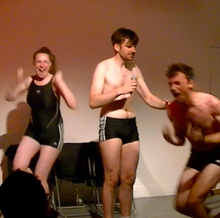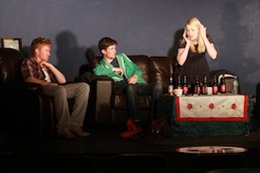ITM critics Siobhán O'Gorman and Brendan Daly attended Galway Fringe Festival 2013.
Ballykilldowna
ThereisBear!
The Townhouse Bar
Reviewed 20 July
Bean Uí Hynes is a recognisable character from any Irish village. The lifeblood of the local GAA club, she is unfailingly at the side-line for every match and makes tea and her homemade brown bread for the team afterwards. Her sudden death coincides with Ballykilldowna’s hurling final victory and devastates her beloved grandson, Des, leaving him bereft of any family. Des, who has cystic fibrosis, is in love with his best friend, Megan, but she is with Jason, Ballykilldowna’s team captain. When Des dies, the memory of his fledgling romance with Megan corrupts Megan and Jason’s relationship.
Director Darragh O’Brien vividly communicates this drama’s love triangle and how Des’s death casts a shadow over Megan and Jason. As the audience enters, all three characters (motionless, their heads bowed), with Des in the middle, form a literal triangle and this is a motif of the production. When Megan and Jason argue after Des’s death, his character’s ghost is physically located between them.
Joe Power’s expressive performance reveals Des’s physical and emotional fragility, but also his fury at being viewed as stoically enduring his illness. In a wheelchair for part of the production, through him we glimpse his resentment at his life’s trajectory and the weight of his belated realisation that Megan reciprocates his feelings.
Jason is persuasively played by Peter Hubert Shine. In sequences where Jason recalls the match in which he received a serious injury, Shine’s portrayal bristles with visceral energy, channelling a feral animal in a cage. This is balanced against the tenderness of his relationship with Megan and his growing disillusion at its demise.
Muireann Ní Raghallaigh essays Megan with an aloofness that seems inconsistent with her character’s resilience and, in a play that features many loud exchanges, Ní Raghallaigh’s subdued characterisation is slightly obscured by her fellow performers.
However, this production is marked by fluid ensemble playing: at one stage, Leonard’s script simultaneously intertwines each character articulating the frustration of their own particular predicament and, here, the actors deftly choreograph their characters’ “I don’t want to be here anymore” refrain.
Shaun Leonard’s sinewy script wrestles with topics as divergent as the claustrophobia of small-town life to the pressures of conforming to machismo ideals. But it is hamstrung by its convention of depicting chunks of its story through direct address, which stymies early parts of the play. This spirited ThereisBear! production employed a basic set and would have benefited from a more coherent approach to costuming to better evoke its shifting locales.
BD
This Happened in the City Jail (The Story of Hansel and Gretel)
Dhá Lámh Theatre
Galway Courthouse
Reviewed 20 July
“That was a load of crap!” bellows a voice after the performance, “I could do better myself.” Then the voice announces its intention: “I’ll write my own play.” It’s the voice of a character: a participant on a drama course held in a prison and is part of the coda to This Happened in the City Jail (The Story of Hansel and Gretel).
The kernel of Laura Mulcahy’s script is a mise en abyme: the ‘performance’ we thought we were witnessing was, in fact, taking place within the play. When that play ends, three black-clad characters appear on stage to give their opinion of the piece, and one outlines her artistic plan and discusses her family history. The script of This Happened in the City Jail was “inspired” by Mulcahy’s work as a drama facilitator in Mountjoy Prison.
The production was presented in the foyer of Galway Courthouse (an official sign near the set reads ‘Jurors: Court No. 1’ and shows a pointed arrow). The set consists of a series of portable metal frames decorated with clothes.
The ‘first’ play reimagines 'Hansel and Gretel' for a contemporary audience: under the weight of a crippling mortgage, a bitter Wife (Annemarie O’Connell) prevails on a brow-beaten Husband (Alex Mulcahy) to abandon their children, Hansel (Martina Corry) and Gretel (Ailise Corry), in the forest where they encounter the sinister Witch (Margaret Corry), complete with villainous laugh.
In a rhyming script (e.g., “Let’s get going, stop this talk/Sing a song while we walk”), Mulcahy’s unhurried direction blends mime, dance and performance art and elicits enthusiastic responses from the non-professional cast. The atmospheric lighting and horror film music help suggest the dark forces besetting Hansel and Gretel in the forest.
If the overall production lacks cohesion, the unnamed prison character’s recollection of her own life (delivered directly to the audience) lend a poignant authenticity to the play’s close.
BD
The Three Friends
Side-Show Productions
Townhouse Bar, Galway
Reviewed 25 July
The team were still setting up when the audience entered. The performers appeared amateur and their roles, rudimentary. And joke after joke offered exactly the same punch-line—if you could call it a punch-line. But this is exactly what had an eclectic mix of tourists and locals laughing heartily throughout the Galway production of Side-Show’s recent work of comedy theatre: The Three Friends. Inspired by the American sitcom Perfect Strangers (1986-1993), The Three Friends blends awkwardness, cheesiness and stupidity to satirise the conventions of various comic forms.
 After the actors had finished pestering spectators to help them set up equipment, Dick Walsh and Tom Walsh staged an extended, energetic build-up to what they promised would be an evening of top-class improvised sketches, presenting each performer’s local achievements as if these were proof of global acclaim, and gaining copious claps and cheers from what was fortunately a giddy, interactive audience. While Walsh and Walsh sustained their idiotic effervescence for much of the production, Meabhdh Haceid’s comedy persona was more gormless and subdued, resembling that of Maeve Higgins. Occasionally, Haceid’s chemistry with the other two could have been better developed, but she was a late addition to the team so this was understandable.
After the actors had finished pestering spectators to help them set up equipment, Dick Walsh and Tom Walsh staged an extended, energetic build-up to what they promised would be an evening of top-class improvised sketches, presenting each performer’s local achievements as if these were proof of global acclaim, and gaining copious claps and cheers from what was fortunately a giddy, interactive audience. While Walsh and Walsh sustained their idiotic effervescence for much of the production, Meabhdh Haceid’s comedy persona was more gormless and subdued, resembling that of Maeve Higgins. Occasionally, Haceid’s chemistry with the other two could have been better developed, but she was a late addition to the team so this was understandable.
The sketches were ridiculously mundane, as well as deliberately ill-timed and out of sync. These ‘three friends’—clad, inexplicably, in swimwear—took their friendliness with each other and the crowd to hilariously uncomfortable levels, for example when Dick Walsh insisted on squashing in between a group of young men in the front row, and when his character was reunited with the ‘Old Friend’ (Tom Walsh), with the two wrestling merrily on the floor to Simon and Garfunkel’s ‘Old Friends’. Throughout, costumes and music added to the ludicrous hilarity of the production. The Three Friends is fantastic fun.
SO'G
Tír na nÓg
Just Friends
The Space @ The Bentley
Reviewed 20 July
Retreating from Galway’s blazing tropical sunshine, it’s a mildly jolting experience to confront a set festooned with Christmas decorations and bathed in the glow of the Wham! perennial 'Last Christmas'. But that unintentional rupture is a fitting precursor for Just Friends’s imaginative retelling of the Irish folktale 'Tír na nÓg', as writer and director Aisling Smith’s comedy switches the action to contemporary Dublin.
The play opens shortly before Christmas 2012 and 24-year-old Oisín (Michael O’Toole) is just back in the capital. Three months earlier, he followed Niamh, a girl he’d just met, to London. When Oisín’s college friends Eoghan (Colm Kenny-Vaughan) and Mark (David Copland) call to see him, it emerges that Oisín’s departure unwittingly precipitated changes in his best friends’ lives; they feel it was their cue to grow up. Mark’s girlfriend of three months is pregnant and he is about to propose, while Eoghan has a new girlfriend, Sarah (Rachel Roche). When she tells them a story that explodes Mark’s wedding plans, it unfurls a night of admission and realisation.
O’Toole effectively conveys how Oisín’s initial nonchalance is supplanted by frustration and a longing for home, while Kenny-Vaughan’s downcast expression and restrained movements underline Eoghan’s belief – and sense of helplessness – that his friends’ lives are eclipsing his. Copland convincingly portrays Mark’s journey from dutiful, aspirant father to dishevelled, bewildered drunk. Most impressive, however, is Roche, who both astutely essays her character’s veneer, and then affectingly reveals Rachel’s intelligence and insecurities, encapsulating the production’s overarching focus on the tension between appearance and reality.
Smith’s smart script, anchoring its verisimilitude in a liberal sprinkling of swear words, assuredly juggles a variety of other themes. The difference between how men and women communicate is explored, but Smith is more interested in how new technologies influence the way we communicate with each other.
 A central preoccupation is the fraught negotiations involved in moving from student life to adulthood and how this is complicated by unemployment (Eoghan qualified as an engineer but works in Spar) and emigration. “It’s not what I signed up for,” says a weary Oisín. This production concentrates on the competition between home and exile as Oisín sprightly teases out with Sarah the parallels between the ancient legend and his modern predicament. Oisín, resentful that he has to disrupt his life to pursue Niamh to London, rails against the mythical Niamh (“She lied by omission”), while the parallels between Oisín returning after three months to changed circumstances and the mythical Oisín aging instantly after 300 years in Tír na nÓg are perceptively woven into the action.
A central preoccupation is the fraught negotiations involved in moving from student life to adulthood and how this is complicated by unemployment (Eoghan qualified as an engineer but works in Spar) and emigration. “It’s not what I signed up for,” says a weary Oisín. This production concentrates on the competition between home and exile as Oisín sprightly teases out with Sarah the parallels between the ancient legend and his modern predicament. Oisín, resentful that he has to disrupt his life to pursue Niamh to London, rails against the mythical Niamh (“She lied by omission”), while the parallels between Oisín returning after three months to changed circumstances and the mythical Oisín aging instantly after 300 years in Tír na nÓg are perceptively woven into the action.
While it seems implausible that a group of privileged friends in their mid-20s would fret so conspicuously about their desperation to “settle down”, it’s a minor criticism in an accomplished production that zings with lines like Eoghan’s description of Sarah: “She’s kind, good-looking and she lives on the 46A route.”
BD
Brendan Daly is a freelance arts journalist and critic for publications in Ireland and the U.S.
Siobhán O’Gorman lectures on early modern, modern and contemporary drama and researches scenography in Irish theatre.